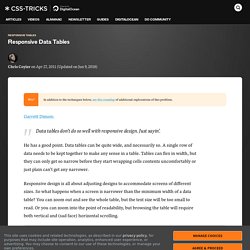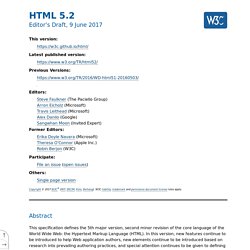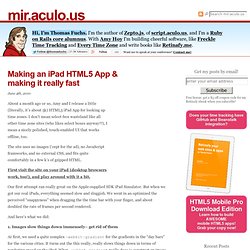Zoom
Trash

Mobile JavaScript Framework for Developing HTML5 Web Apps. Tutorials. Www.nihilogic.dk/labs/canvas_sheet/HTML5_Canvas_Cheat_Sheet.pdf. CSS3 Please! The Cross-Browser CSS3 Rule Generator. Responsive Data Tables. In addition to the techniques below, see this roundup of additional explorations of this problem.

Garrett Dimon: Data tables don't do so well with responsive design. Just sayin'. He has a good point. Data tables can be quite wide, and necessarily so. Responsive design is all about adjusting designs to accomodate screens of different sizes. So here's what we are gonna do... We're going to use "responsive design" principles (CSS @media queries) to detect if the screen is smaller than the maximum squishitude of our table. We're being good little developers and using Plain Ol' Semantic Markup here for our table. <table><thead><tr><th>First Name</th><th>Last Name</th><th>Job Title</th></tr></thead><tbody><tr><td>James</td><td>Matman</td><td>Chief Sandwich Eater</td></tr><tr><td>The</td><td>Tick</td><td>Crimefighter Sorta</td></tr></tbody></table> Our regular CSS is nothing special: The small-screen responsive stuff comes in now.
Hey what about IE? See it View Demo Download Files UPDATE: Other ideas. Art of Stars in HTML5 - NakshART. HTML5 specs. This specification defines the 5th major version, second minor revision of the core language of the World Wide Web: the Hypertext Markup Language (HTML).

In this version, new features continue to be introduced to help Web application authors, new elements continue to be introduced based on research into prevailing authoring practices, and special attention continues to be given to defining clear conformance criteria for user agents in an effort to improve interoperability. This section describes the status of this document at the time of its publication. Other documents may supersede this document.
A list of current W3C publications and the latest revision of this technical report can be found in the W3C technical reports index at This document was published by the Web Platform Working Group as a Editors Draft. Publication as a Editors Draft does not imply endorsement by the W3C Membership. This document was produced by a group operating under the 5 February 2004 W3C Patent Policy. Making an iPad HTML5 App & making it really fast. June 4th, 2010 About a month ago or so, Amy and I release a little (literally, it’s about 5k) HTML5 iPad App for looking up time zones.

I don’t mean select-box wasteland like all other time zone sites (who likes select boxes anyway?!) , I mean a nicely polished, touch-enabled UI that works offline, too. The site uses no images (‘cept for the ad), no JavaScript framworks, and no external CSS, and fits quite comfortably in a few k’s of gzipped HTML. First visit the site on your iPad (desktop browsers work, too!) Our first attempt ran really great on the Apple-supplied SDK iPad Simulator. And here’s what we did: 1. At first, we used a quite complex -webkit-gradient for the gradients in the “day bars” for the various cities. We replaced those bars with a big canvas element that sits in the background, and we redraw only those portions of the screen that undergoes changes (the different highlighting when you drag around the green bar). 2.
Also a major source of slowdown. 3. 4.